Topic 06 饮食文化二轮专题学案(含答案解析)-2025年初中英语中考传统文化阅读与写作专练(第二期)
文档属性
| 名称 | Topic 06 饮食文化二轮专题学案(含答案解析)-2025年初中英语中考传统文化阅读与写作专练(第二期) | 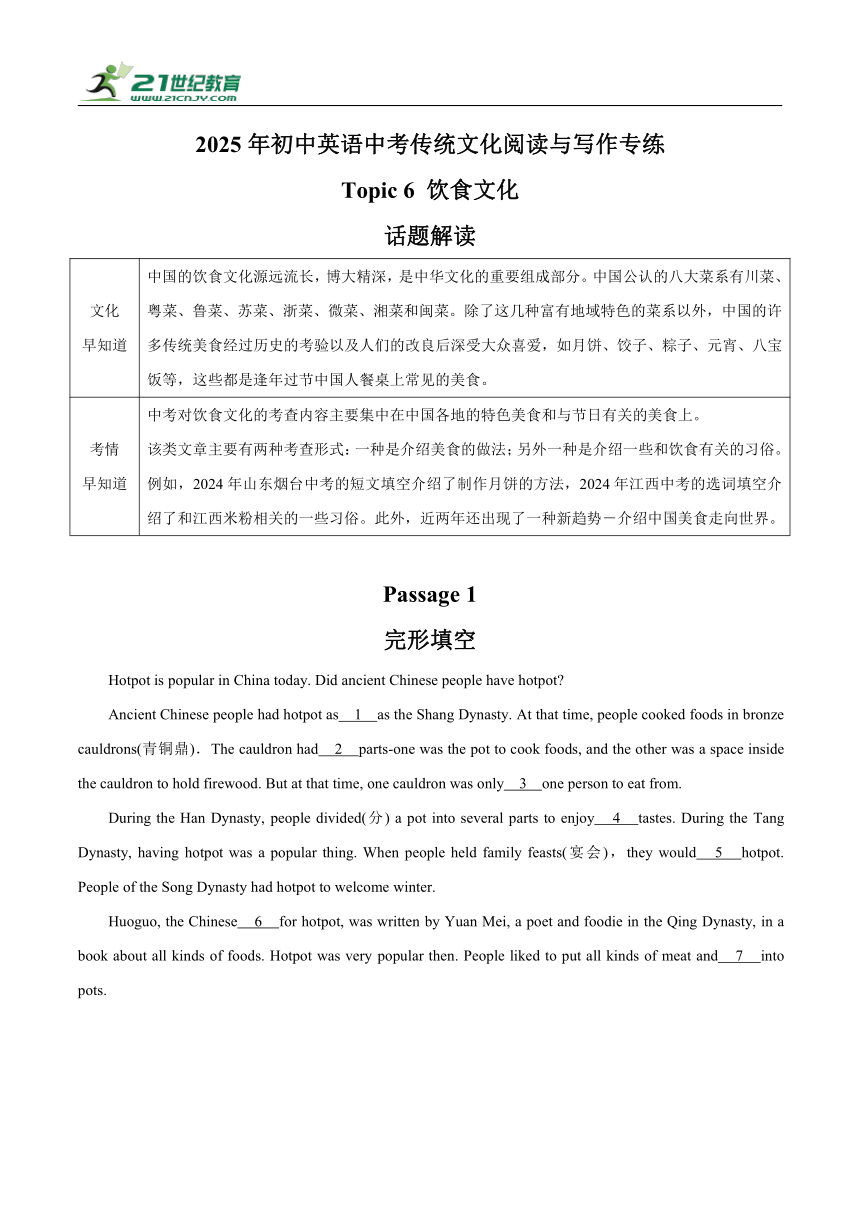 | |
| 格式 | docx | ||
| 文件大小 | 102.9KB | ||
| 资源类型 | 试卷 | ||
| 版本资源 | 人教新目标(Go for it)版 | ||
| 科目 | 英语 | ||
| 更新时间 | 2025-04-13 20:49:59 | ||
图片预览

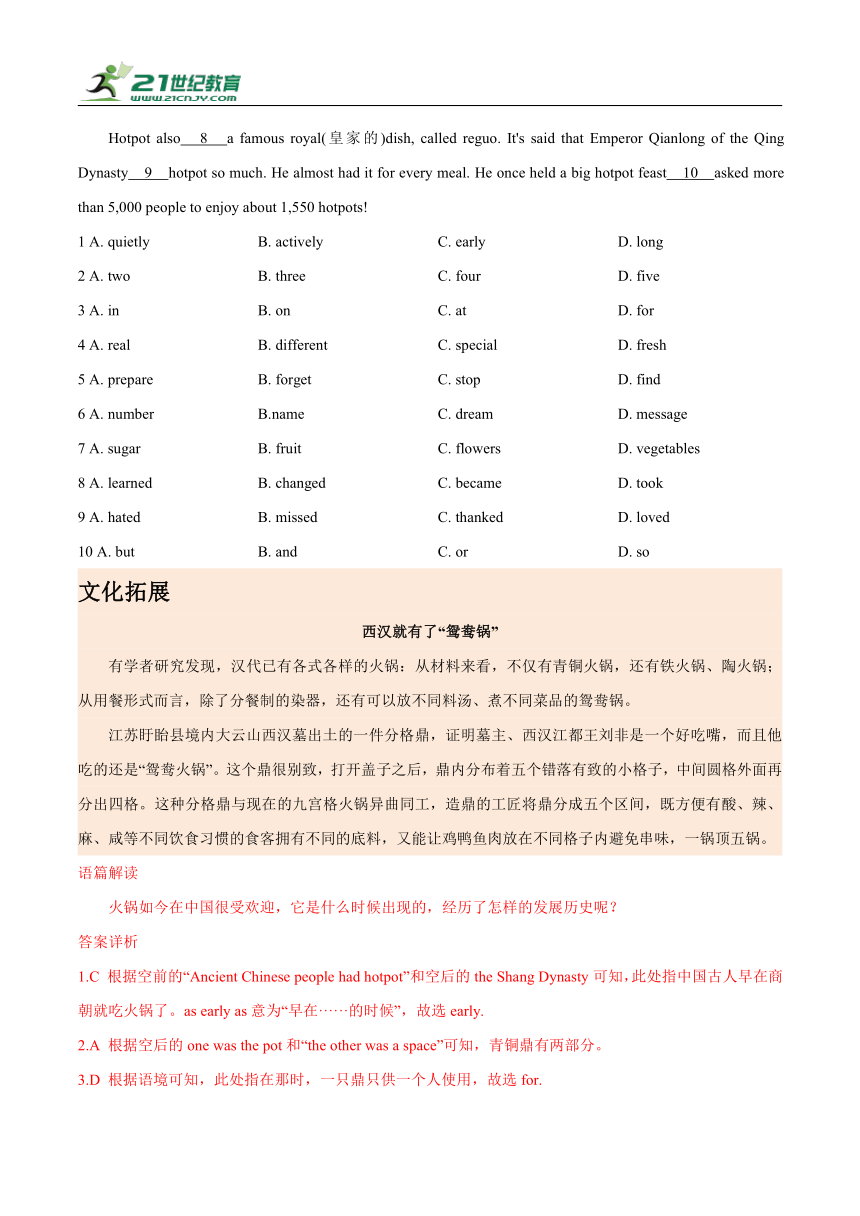
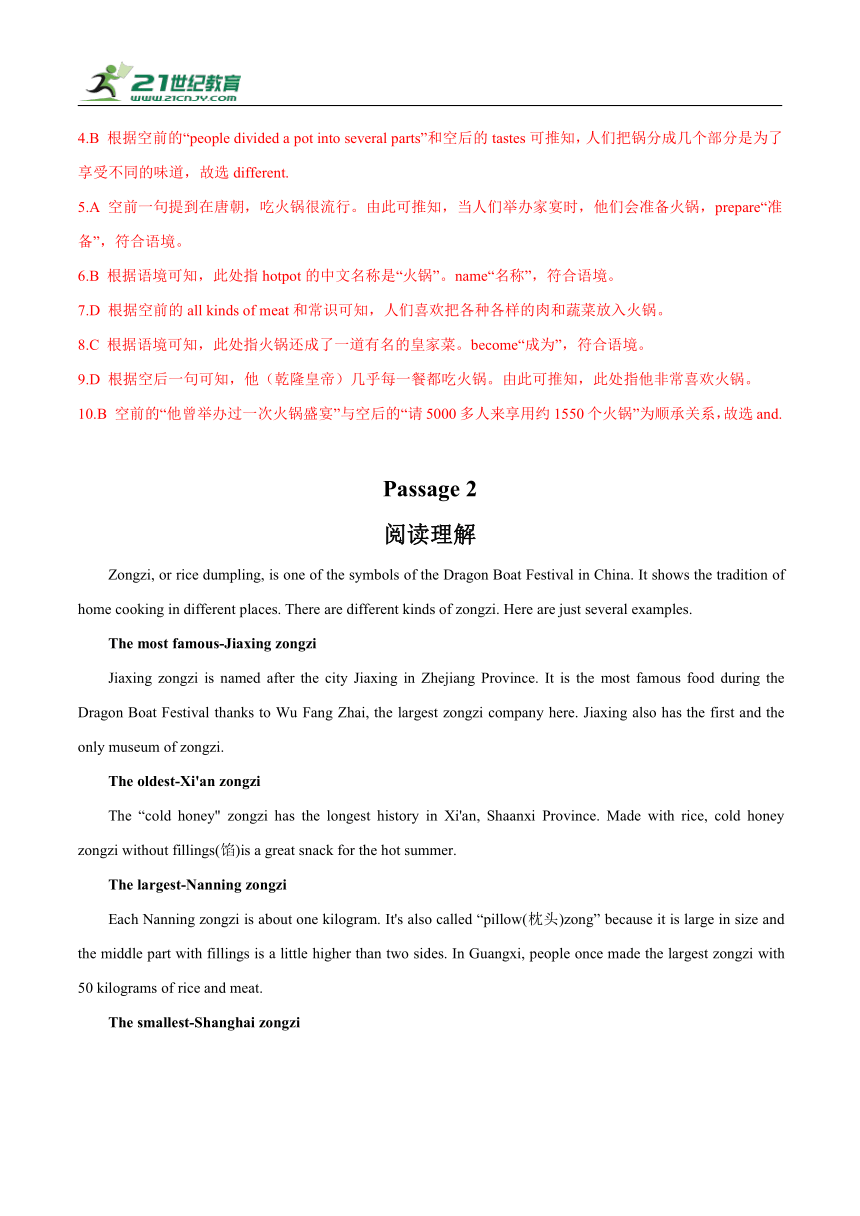
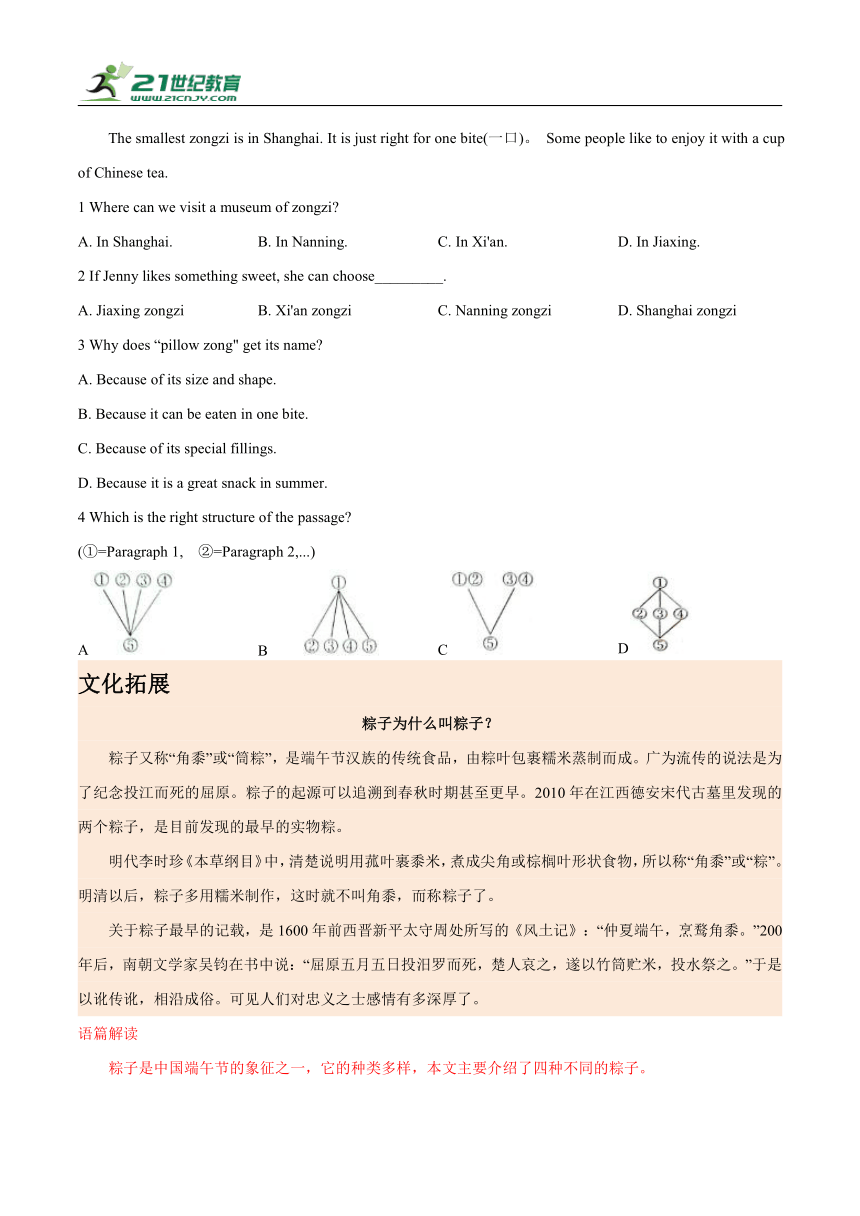
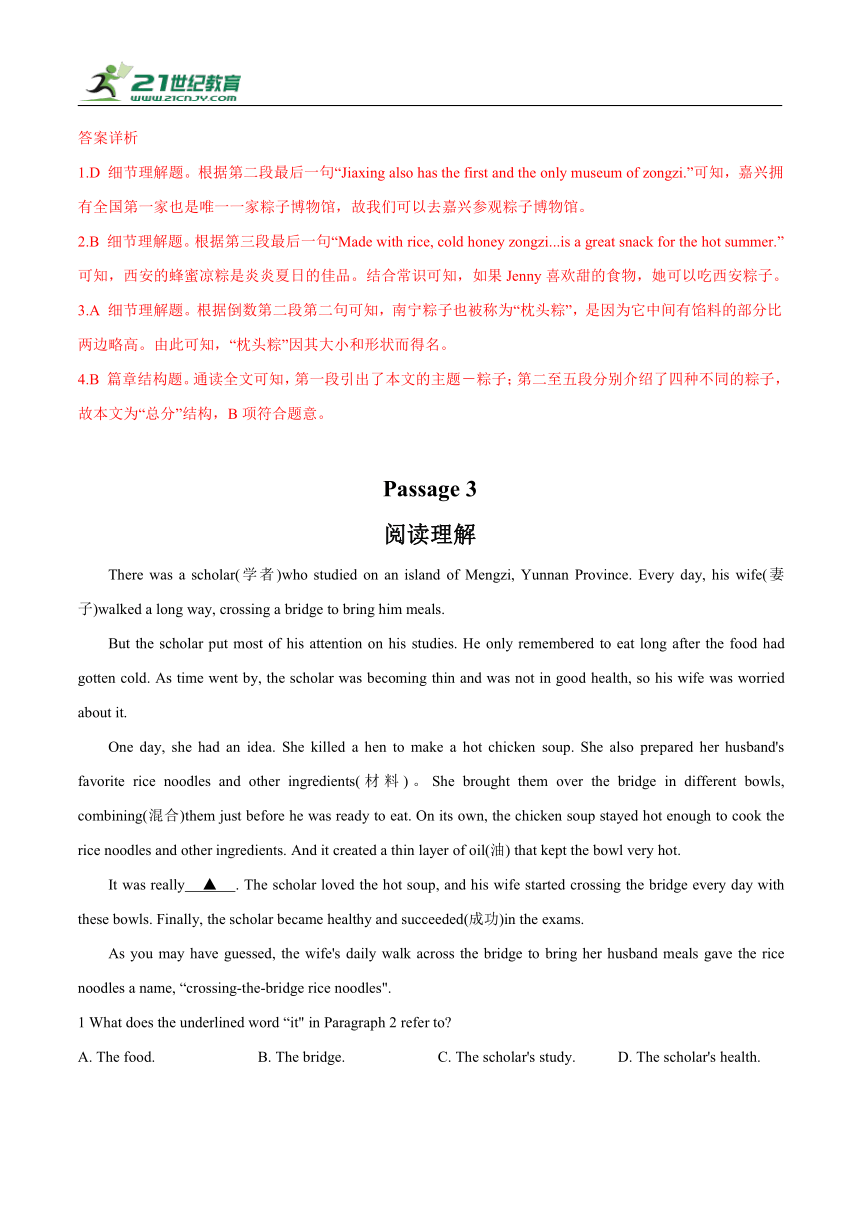
文档简介
2025年初中英语中考传统文化阅读与写作专练
Topic 6 饮食文化
话题解读
文化 早知道 中国的饮食文化源远流长,博大精深,是中华文化的重要组成部分。中国公认的八大菜系有川菜、粤菜、鲁菜、苏菜、浙菜、微菜、湘菜和闽菜。除了这几种富有地域特色的菜系以外,中国的许多传统美食经过历史的考验以及人们的改良后深受大众喜爱,如月饼、饺子、粽子、元宵、八宝饭等,这些都是逢年过节中国人餐桌上常见的美食。
考情 早知道 中考对饮食文化的考查内容主要集中在中国各地的特色美食和与节日有关的美食上。 该类文章主要有两种考查形式:一种是介绍美食的做法;另外一种是介绍一些和饮食有关的习俗。例如,2024年山东烟台中考的短文填空介绍了制作月饼的方法,2024年江西中考的选词填空介绍了和江西米粉相关的一些习俗。此外,近两年还出现了一种新趋势-介绍中国美食走向世界。
Passage 1
完形填空
Hotpot is popular in China today. Did ancient Chinese people have hotpot
Ancient Chinese people had hotpot as 1 as the Shang Dynasty. At that time, people cooked foods in bronze cauldrons(青铜鼎).The cauldron had 2 parts-one was the pot to cook foods, and the other was a space inside the cauldron to hold firewood. But at that time, one cauldron was only 3 one person to eat from.
During the Han Dynasty, people divided(分) a pot into several parts to enjoy 4 tastes. During the Tang Dynasty, having hotpot was a popular thing. When people held family feasts(宴会),they would 5 hotpot. People of the Song Dynasty had hotpot to welcome winter.
Huoguo, the Chinese 6 for hotpot, was written by Yuan Mei, a poet and foodie in the Qing Dynasty, in a book about all kinds of foods. Hotpot was very popular then. People liked to put all kinds of meat and 7 into pots.
Hotpot also 8 a famous royal(皇家的)dish, called reguo. It's said that Emperor Qianlong of the Qing Dynasty 9 hotpot so much. He almost had it for every meal. He once held a big hotpot feast 10 asked more than 5,000 people to enjoy about 1,550 hotpots!
1 A. quietly B. actively C. early D. long
2 A. two B. three C. four D. five
3 A. in B. on C. at D. for
4 A. real B. different C. special D. fresh
5 A. prepare B. forget C. stop D. find
6 A. number B.name C. dream D. message
7 A. sugar B. fruit C. flowers D. vegetables
8 A. learned B. changed C. became D. took
9 A. hated B. missed C. thanked D. loved
10 A. but B. and C. or D. so
文化拓展
西汉就有了“鸳鸯锅”
有学者研究发现,汉代已有各式各样的火锅:从材料来看,不仅有青铜火锅,还有铁火锅、陶火锅;从用餐形式而言,除了分餐制的染器,还有可以放不同料汤、煮不同菜品的鸳鸯锅。
江苏盱眙县境内大云山西汉墓出土的一件分格鼎,证明墓主、西汉江都王刘非是一个好吃嘴,而且他吃的还是“鸳鸯火锅”。这个鼎很别致,打开盖子之后,鼎内分布着五个错落有致的小格子,中间圆格外面再分出四格。这种分格鼎与现在的九宫格火锅异曲同工,造鼎的工匠将鼎分成五个区间,既方便有酸、辣、麻、咸等不同饮食习惯的食客拥有不同的底料,又能让鸡鸭鱼肉放在不同格子内避免串味,一锅顶五锅。
语篇解读
火锅如今在中国很受欢迎,它是什么时候出现的,经历了怎样的发展历史呢?
答案详析
1.C 根据空前的“Ancient Chinese people had hotpot”和空后的the Shang Dynasty可知,此处指中国古人早在商朝就吃火锅了。as early as意为“早在······的时候”,故选early.
2.A 根据空后的one was the pot和“the other was a space”可知,青铜鼎有两部分。
3.D 根据语境可知,此处指在那时,一只鼎只供一个人使用,故选for.
4.B 根据空前的“people divided a pot into several parts”和空后的tastes可推知,人们把锅分成几个部分是为了享受不同的味道,故选different.
5.A 空前一句提到在唐朝,吃火锅很流行。由此可推知,当人们举办家宴时,他们会准备火锅,prepare“准备”,符合语境。
6.B 根据语境可知,此处指hotpot的中文名称是“火锅”。name“名称”,符合语境。
7.D 根据空前的all kinds of meat和常识可知,人们喜欢把各种各样的肉和蔬菜放入火锅。
8.C 根据语境可知,此处指火锅还成了一道有名的皇家菜。become“成为”,符合语境。
9.D 根据空后一句可知,他(乾隆皇帝)几乎每一餐都吃火锅。由此可推知,此处指他非常喜欢火锅。
10.B 空前的“他曾举办过一次火锅盛宴”与空后的“请5000多人来享用约1550个火锅”为顺承关系,故选and.
Passage 2
阅读理解
Zongzi, or rice dumpling, is one of the symbols of the Dragon Boat Festival in China. It shows the tradition of home cooking in different places. There are different kinds of zongzi. Here are just several examples.
The most famous-Jiaxing zongzi
Jiaxing zongzi is named after the city Jiaxing in Zhejiang Province. It is the most famous food during the Dragon Boat Festival thanks to Wu Fang Zhai, the largest zongzi company here. Jiaxing also has the first and the only museum of zongzi.
The oldest-Xi'an zongzi
The “cold honey" zongzi has the longest history in Xi'an, Shaanxi Province. Made with rice, cold honey zongzi without fillings(馅)is a great snack for the hot summer.
The largest-Nanning zongzi
Each Nanning zongzi is about one kilogram. It's also called “pillow(枕头)zong” because it is large in size and the middle part with fillings is a little higher than two sides. In Guangxi, people once made the largest zongzi with 50 kilograms of rice and meat.
The smallest-Shanghai zongzi
The smallest zongzi is in Shanghai. It is just right for one bite(一口)。 Some people like to enjoy it with a cup of Chinese tea.
1 Where can we visit a museum of zongzi
A. In Shanghai. B. In Nanning. C. In Xi'an. D. In Jiaxing.
2 If Jenny likes something sweet, she can choose_________.
A. Jiaxing zongzi B. Xi'an zongzi C. Nanning zongzi D. Shanghai zongzi
3 Why does “pillow zong" get its name
A. Because of its size and shape.
B. Because it can be eaten in one bite.
C. Because of its special fillings.
D. Because it is a great snack in summer.
4 Which is the right structure of the passage
(①=Paragraph 1, ②=Paragraph 2,...)
A B C D
文化拓展
粽子为什么叫粽子?
粽子又称“角黍”或“筒粽”,是端午节汉族的传统食品,由粽叶包裹糯米蒸制而成。广为流传的说法是为了纪念投江而死的屈原。粽子的起源可以追溯到春秋时期甚至更早。2010年在江西德安宋代古墓里发现的两个粽子,是目前发现的最早的实物粽。
明代李时珍《本草纲目》中,清楚说明用菰叶裹黍米,煮成尖角或棕榈叶形状食物,所以称“角黍”或“粽”。明清以后,粽子多用糯米制作,这时就不叫角黍,而称粽子了。
关于粽子最早的记载,是1600年前西晋新平太守周处所写的《风土记》:“仲夏端午,烹鹜角黍。”200年后,南朝文学家吴钧在书中说:“屈原五月五日投汨罗而死,楚人哀之,遂以竹筒贮米,投水祭之。”于是以讹传讹,相沿成俗。可见人们对忠义之士感情有多深厚了。
语篇解读
粽子是中国端午节的象征之一,它的种类多样,本文主要介绍了四种不同的粽子。
答案详析
1.D 细节理解题。根据第二段最后一句“Jiaxing also has the first and the only museum of zongzi.”可知,嘉兴拥有全国第一家也是唯一一家粽子博物馆,故我们可以去嘉兴参观粽子博物馆。
2.B 细节理解题。根据第三段最后一句“Made with rice, cold honey zongzi...is a great snack for the hot summer.”可知,西安的蜂蜜凉粽是炎炎夏日的佳品。结合常识可知,如果Jenny喜欢甜的食物,她可以吃西安粽子。
3.A 细节理解题。根据倒数第二段第二句可知,南宁粽子也被称为“枕头粽”,是因为它中间有馅料的部分比两边略高。由此可知,“枕头粽”因其大小和形状而得名。
4.B 篇章结构题。通读全文可知,第一段引出了本文的主题-粽子;第二至五段分别介绍了四种不同的粽子,故本文为“总分”结构,B项符合题意。
Passage 3
阅读理解
There was a scholar(学者)who studied on an island of Mengzi, Yunnan Province. Every day, his wife(妻子)walked a long way, crossing a bridge to bring him meals.
But the scholar put most of his attention on his studies. He only remembered to eat long after the food had gotten cold. As time went by, the scholar was becoming thin and was not in good health, so his wife was worried about it.
One day, she had an idea. She killed a hen to make a hot chicken soup. She also prepared her husband's favorite rice noodles and other ingredients(材料)。She brought them over the bridge in different bowls, combining(混合)them just before he was ready to eat. On its own, the chicken soup stayed hot enough to cook the rice noodles and other ingredients. And it created a thin layer of oil(油) that kept the bowl very hot.
It was really ▲ . The scholar loved the hot soup, and his wife started crossing the bridge every day with these bowls. Finally, the scholar became healthy and succeeded(成功)in the exams.
As you may have guessed, the wife's daily walk across the bridge to bring her husband meals gave the rice noodles a name, “crossing-the-bridge rice noodles".
1 What does the underlined word “it" in Paragraph 2 refer to
A. The food. B. The bridge. C. The scholar's study. D. The scholar's health.
2 What made the bowl keep hot
A. Rice noodles. B. Vegetables.
C. The wife's shorter walk. D. The oil on the chicken soup.
3 Which of the following can be put into the “ ▲ ”?
A. interesting B. useful C. hard D. safe
4 From the passage, we can know that the wife________ .
A. was a very smart woman
B. often ran quickly to the island
C. enjoyed chicken soup very much
D. was interested in her husband's study
5 What's the best title of the passage
A.A healthy and successful scholar
B. A bridge between the scholar and his wife
C. The story behind crossing-the-bridge rice noodles
D. The way of eating crossing-the-bridge rice noodles
文化拓展
过桥米线:一碗容天下鲜
“过桥米线”当是云南民族饮食奇绝中之冠绝,绝在“无火烹饪”技术独树一帜,绝在“容”天下之鲜于一碗中。盛于大碗中的高汤,表面上不冒一丝热气,但由于汤面浮有一层铜钱厚的热油保温,汤的温度长时间保持在95摄氏度以上,一招“无火烹饪”绝技可1秒煮熟蛋,5秒烫熟肉......
享用时,生肉滚上一道鹌鹑蛋液后放入汤中,熟肉随后,菊花瓣紧跟,之后是豆腐皮、豌豆砣、素菜···最后放入米线。几涮之间,生肉生食迅速氽熟。食材与汤汁完美融合,鲜美馥郁之余,又不会因长时间烹煮而破坏食材本身的味道。
一碗过桥米线,浮油鲜汤,食材斑斓,容天下之鲜于方寸间。食客雅座躬身,“过桥”而食,惬意之至。
语篇解读
过桥米线是滇菜的代表美食,本文主要讲述了它的由来。
答案详析
1.D 代词指代题。根据上文内容可知,妻子每天都给在岛上学习的丈夫送饭,但是吃了凉饭菜的丈夫日渐消瘦,健康也出了问题。结合语境可知,此处指妻子担心丈夫的健康,故it指代the scholar's health.
2.D 细节理解题。根据第三段最后一句“And it created a thin layer of oil that kept the bowl very hot.”可知,鸡汤表面产生的油脂让碗保持高的温度。
3.B 词语还原题。根据上一段可知,学者的妻子想了一个方法来让饭保温;再结合下文可知,她的丈夫很喜欢热汤,身体也变得健康起来。由此推断,她的方法是非常有用的。
4.A 推理判断题。通读全文可知,由于学者经常吃冷饭菜,他的身体每况愈下,他的妻子便想了一个方法来让饭保温,最后学者的身体变得健康起来。由此推断,学者的妻子是非常聪明的。
5.C 标题归纳题。通读全文可知,本文主要讲述了过桥米线的由来,故C项最适合作本文标题。
Passage 4
阅读理解
Do you know something about qingtuan Have you ever eaten it before Weeks before the Qingming Festival, lots of qingtuan are sold each day.
In the southern part of China, eating qingtuan during the festival is a kind of tradition. It is usually made of sticky rice(糯米)and red bean paste(红豆沙)。The secret behind its good taste is the mugwort leaves(艾蒿叶)。The plant mainly grows in the Yangtze River Delta. People here usually put qingtuan on the tombs(墓)of their dead family members to cherish the past memory. Making qingtuan is also a time for families to get together at home.
Now, qingtuan has already spread(传播)its special taste to the northern part of China. Li Yuan, who grew up in Zhejiang Province, brought qingtuan back to Beijing, where he works.“It tastes different in and out of my hometown," he said.“There's no place like home.”
Lots of things can be put in qingtuan, such as apples and pears, to meet people's tastes. The difference of the taste shows that it's getting more and more popular all over China.
1 How does the writerintroduce the topic
A. By telling stories. B. By asking questions. C. By listing numbers. D. By giving examples.
2 Which question does Paragraph 2 answer
A. How do people make qingtuan
B. When do people grow mugwort
C. Why are mugwort leaves popular
D. What is qingtuan usually made of
3 What does the underlined word “cherish” in Paragraph 2 probably mean
A.遗忘 B.怀念 C.祈求 D.感谢
4 What can we know from the passage
A. Li Yuan grew up in Beijing.
B. Making qingtuan is an exciting thing for Li Yuan.
C. More and more people will enjoy eating qingtuan.
D. People can find mugwort only in the Yangtze River Delta.
5 What is the passage mainly about
A. An interesting activity.
B. A kind of traditional food.
C. The history of the Qingming Festival.
D. The difference between north and south.
文化拓展
清明吃寒食 青团圆又甜
清明时节,江南地区有吃青团的习俗。江南人将春季第一次吃青团称为“尝春”,品尝春天味道的同时,亦寄托对先人的思念。
据考证,“青团”之称大约始于唐代,又叫艾团。清代文人徐达源《吴门竹枝词》中的“相传百五禁烟厨,红藕青团各祭先”,说的就是人们在清明时节吃冷食青团,并用红藕、青团祭祀祖先,其中“百五”即指冬至过后105天为寒食。
清代文学家、美食家袁枚在《随园食单》中记载了青团的制作方法-“捣青草为汁,和粉作团,色如碧玉”。当下常见的青团制作方法与袁枚记录的如出一辙。
语篇解读
本文主要介绍了人们在清明时节吃的一种传统食物-青团。青团通常由糯米和红豆沙制成,其美味背后的秘密是艾蒿叶。
答案详析
1.B 推理判断题。根据第一段前两句可知,作者在文章开头提出了两个问题,故作者通过提问题的方式引出本文主题-青团。
2.D 细节理解题。通读第二段可知,在中国南方,清明吃青团是一种传统。青团通常由糯米和红豆沙制成。由此可知,第二段提到了制作青团的材料。
3.B 词义猜测题。根据画线词前的“People here usually put qingtuan on the tombs of their dead family members”可知,人们通常会把青团放在已故家人的坟墓上。再结合画线词后的the past memory可推知,他们这样做是为了怀念往事,故推断cherish意为“怀念”。
4.C 推理判断题。根据第三段第一句“Now, qingtuan has already spread its special taste to the northern part of China.”可知,现在,青团的特殊味道已经传到了中国北方。再结合文章最后一句可知,口味的差异说明青团在全国各地越来越受欢迎。由此可推知,会有越来越多的人喜欢吃青团。
5.B 主旨大意题。通读全文可知,本文主要介绍了人们在清明时节吃的一种传统食物-青团。
Passage 5
任务型阅读
Xinjiang Uygur Autonomous Region(新疆维吾尔自治区)is a beautiful place with sweet fruit as well as kind people. People there can sing and dance well. 1 Let's have a look!
Naan
As the saying goes,“ One can go without eating meat for three days, but can't live one day without naan." Naan is atraditional food with a history of over 2,000 years in Xinjiang. People usually cook it in a clay oven(泥炉).The shape of the naan is round. 2 So they like to share the food with others.
Xinjiang Big Plate Chicken
It's a famous dish and you can find it all over the country. 3 At first, he was famous for his chicken with chilli peppers. His customers(顾客)enjoyed the taste of the dish, but they thought the portion(分量)was small. This is why Li decided to cook a whole chicken one day, and put it in a big plate. The customers were really happy with the big plate of chicken. 4
Xinjiang Hand-Pulled Noodles
Xinjiang hand-pulled noodles, also known as latiaozi, are a kind of popular Xinjiang food. People introduced the way of cooking noodles to Xinjiang from other parts of northwest China., 5 The special way of cooking attracts(吸引)lots of people and they all like to watch it, especially pulling noodles.
根据短文内容,从所给的选项中选出能填入空白处的最佳选项。(其中一项多余)
A. People think it's a symbol of good luck. B. And the food in Xinjiang is also famous. C. People in Xinjiang eat them to keep healthy. D. After that, lots of orders of the dish came in. E.A cook called Li Shilin created it about 40 years ago. F. The locals(当地人)add mutton and vegetables to the dish now.
1_________ 2_________ 3_________ 4_________ 5_________
文化拓展
新疆美食的六个“离不开”,你知道几个?
1.黄面离不开烤肉。黄面和烤肉可是一对绝配,浓香的烤肉可以让简单的黄面找到豪华盛宴的感觉。
2.米粉离不开馕。馕钟情的只是烤肉吗?当它遇上了米粉,才发现了自己的无限魅力。馕沾上浓厚的米粉酱汁,那份独特无法言喻。
3.手抓肉离不开皮芽子。手抓肉配皮芽子,最简单也是最好的搭配,羊肉鲜香,皮芽子解腻,独一无二的搭配。
4.大盘鸡离不开皮带面。大盘鸡美味非凡的汤汁,只有皮带面才懂。
5.丸子汤离不开油塔子。丸子汤配上油塔子,拎着“塔顶”可以带起整个油塔子,一层一层的垂下去,面薄似纸,酥香可口,一道价廉物美的丸子汤盛宴就可以轻松享受了。
6.奶茶离不开酥油。香甜的奶茶,放一块酥油,用勺子搅拌,入口一股酥油的浓香,营养丰富,口感独特。席间,总有飘散不尽的酥油奶茶香。
语篇解读
本文主要介绍了新疆的三种美食:馕、新疆大盘鸡和新疆拉条子。
答案详析
1.B 空前两句对新疆进行了简单介绍;再结合下文中的三个小标题可知,本文主要介绍了新疆的三种美食。由此可推知,空处应该提到了新疆的美食,故B项“新疆的美食也很有名”可承上启下,符合语境。
2.A 空后一句提到所以他们喜欢与他人分享这种食物(馕)。由此可推知,空处内容应与他们喜欢分享馕的原因有关,故A项“人们认为它是好运的象征”可引出下文,符合语境。空后的they指代A项中的People.
3.E 根据空后一句可知,起初他的辣子炒鸡很有名。由此推断,空处应提到了某个人名,故E项“大约40年前,一个叫李士林的厨师创制了大盘鸡”可引出下文,符合语境。
4.D 根据空前两句可知,李士林做了一整只鸡,并把它放在一个大盘子里,顾客对大盘鸡非常满意,D项“从那以后,这道菜的订单大量涌入”最能说明李士林制作大盘鸡的结果,符合语境。
5.F 上一句提到人们把面条的烹饪方法从中国西北的其他地区引入新疆,下一句提到这种特殊的烹饪方法吸引了很多人。由此可推知,空处内容也应与面条的烹饪方法有关,故F项“如今当地人在这道菜中加入羊肉和蔬菜”可承上启下,符合语境。
Passage 6
短文填空
根据短文内容,从方框中选出正确的单词并用其适当形式填空。
cook how turn they tradition plate piece final with pour
Red braised pork belly, or hongshaorou, tastes delicious. And it is popular 1 people in many places in China. It is a kind of 2 Chinese food. Do you want to learn 3 to make it Here are some steps.
First, prepare half a kilo of nice pork belly and wash it clean. Next, cut the pork into 4 and put them in a pot with cold water for a few minutes. Get the pork out of the pot and dry it up. Then, put the cooking oil(油)into a hot wok(炒菜锅)。Add in some sugar and when it 5 brown, add the pork into the wok, mix them together and cook for, a few minutes. After that, 6 some hot water into the wok and cook for fifteen minutes. Put some soy sauce(酱油)into the wok and cover the wok. Go on 7 for about half an hour. 8 , when the liquid(汁液)dries up, add some pepper to make the red braised pork belly taste better. Get it out of the wok and place it on a 9 .
Now it is time for you to serve the red braised pork belly to your friends and enjoy the delicious food with 10 .
1_________ 2_________ 3_________ 4_________ 5_________
6_________ 7_________ 8_________ 9_________ 10_________
文化拓展
红烧肉为什么惹人爱?
红烧肉的诱人的香味和爽滑的口感是其深受人们喜爱的原因。红烧肉诱人的香味来自一种叫作“美拉德反应”的神奇作用。美拉德反应是氨基酸与糖在受热时发生的一种会产生褐色颜色和很多香气物质的反应。猪肉中有一些蛋白质,红烧的时候,蛋白质中的氨基酸就会与糖发生这种反应,红烧后肉就产生了诱人的黄褐色,并伴随扑鼻的香气。除了诱人的香气,很多人也喜欢红烧肉爽滑的口感。纯瘦肉吃起来会比较硬,还会塞牙缝,但是红烧肉就非常爽滑,这种爽滑的口感主要是因为脂肪的作用。红烧肉脂肪丰富,脂肪对于食物的口感至关重要。对猪肉的质构分析发现,脂肪含量越高,肉质更嫩、弹性也更好,人们会普遍觉得更好吃。
语篇解读
红烧肉味道鲜美,深受人们喜爱。本文主要介绍了这道菜的做法。
答案详析
1.with 根据空前的is popular和空后的people可知,此处考查固定搭配be popular with sb.“受某人欢迎”,故填with.
2.traditional 根据语境并结合常识可推知,红烧肉是一种中国传统食物。分析句子结构可知,空处应作定语修饰空后的Chinese food,故填tradition的形容词形式traditional.
3.how 第二段主要讲述了制作红烧肉的过程,故此处表示“你想学习如何制作红烧肉吗?”。how“如何”,符合语境。
4.pieces 根据空前的cut the pork和空后的“put them in a pot”可推知,此处指将猪肉切成块。piece作“块”讲时为可数名词,且空前无限定词修饰,故填其复数形式pieces.
5.turns 根据空前的Add in some sugar可知,要加入一些糖;再结合空后的brown可推知,此处指当糖变成棕色后。此处描述客观情况,应用一般现在时;从句的主语为it,故填turn的第三人称单数形式turns.
6.pour 根据空后的some hot water并结合备选词可知,此处指向锅中倒入热水。分析句子结构可知,此处为祈使句,故填动词原形pour.
7.cooking 根据空前提到的制作步骤可推知,此处指继续煮大约半个小时。go on doing sth.意为“继续做某事”,是固定用法,故填cooking.
8.Finally 根据第二段中的First、Next、Then、After that并结合语境可推知,此处指最后,当汁液变干时,加入一些胡椒粉,使红烧肉的味道更好。分析句子结构可知,空处作状语修饰整个句子,故填副词Finally.单词位于句首,注意首字母大写。
9.plate 结合备选词可知,此处指将红烧肉从锅中捞出,放在盘子里,空前有不定冠词a,故填plate.
10.them 现在,你可以把红烧肉端给你的朋友,和他们一起享受这道美食。空处指代空前的your friends,且作with的宾语,故填they的宾格them.
Passage 7
书面表达
假如你是王凯,你的笔友Eric对中国美食文化很感兴趣。请你给他写一封电子邮件,介绍你喜欢的一种传统美食及其做法,并欢迎对方来中国品尝美食。
要求:
1.词数80~100;
2.开头已给出,不计入总词数;
3.要点齐全,行文连贯,可适当发挥。
参考词汇:dumpling skins 饺子皮;fillings馅;fold包;boiling water沸水
Dear Eric,
I am glad to know you are interested in traditional Chinese food._____________________________________
____________________________________________________________________________________________
____________________________________________________________________________________________
____________________________________________________________________________________________
____________________________________________________________________________________________
____________________________________________________________________________________________
____________________________________________________________________________________________
____________________________________________________________________________________________
____________________________________________________________________________________________
Yours,
Wang Kai
参考范文
I am glad to know you are interested in traditional Chinese food. Dumplings are my favorite food and I will teach you how to make the food.
To begin with, prpare some dumpling skins. Then, mix different kinds of vegetables and meat to make fill- ings. Next, put fillings onto dumpling skins and fold them into the shape of yuanbao. Finally, it's time to put dumplings into boiling water. Cook them for about five to eight minutes. Don't forget to turn off the fire!
Dumplings are really delicious. I hope you can come to China someday and enjoy different kinds of delicious food.
Yours,
Wang Kai
Topic 6 饮食文化
话题解读
文化 早知道 中国的饮食文化源远流长,博大精深,是中华文化的重要组成部分。中国公认的八大菜系有川菜、粤菜、鲁菜、苏菜、浙菜、微菜、湘菜和闽菜。除了这几种富有地域特色的菜系以外,中国的许多传统美食经过历史的考验以及人们的改良后深受大众喜爱,如月饼、饺子、粽子、元宵、八宝饭等,这些都是逢年过节中国人餐桌上常见的美食。
考情 早知道 中考对饮食文化的考查内容主要集中在中国各地的特色美食和与节日有关的美食上。 该类文章主要有两种考查形式:一种是介绍美食的做法;另外一种是介绍一些和饮食有关的习俗。例如,2024年山东烟台中考的短文填空介绍了制作月饼的方法,2024年江西中考的选词填空介绍了和江西米粉相关的一些习俗。此外,近两年还出现了一种新趋势-介绍中国美食走向世界。
Passage 1
完形填空
Hotpot is popular in China today. Did ancient Chinese people have hotpot
Ancient Chinese people had hotpot as 1 as the Shang Dynasty. At that time, people cooked foods in bronze cauldrons(青铜鼎).The cauldron had 2 parts-one was the pot to cook foods, and the other was a space inside the cauldron to hold firewood. But at that time, one cauldron was only 3 one person to eat from.
During the Han Dynasty, people divided(分) a pot into several parts to enjoy 4 tastes. During the Tang Dynasty, having hotpot was a popular thing. When people held family feasts(宴会),they would 5 hotpot. People of the Song Dynasty had hotpot to welcome winter.
Huoguo, the Chinese 6 for hotpot, was written by Yuan Mei, a poet and foodie in the Qing Dynasty, in a book about all kinds of foods. Hotpot was very popular then. People liked to put all kinds of meat and 7 into pots.
Hotpot also 8 a famous royal(皇家的)dish, called reguo. It's said that Emperor Qianlong of the Qing Dynasty 9 hotpot so much. He almost had it for every meal. He once held a big hotpot feast 10 asked more than 5,000 people to enjoy about 1,550 hotpots!
1 A. quietly B. actively C. early D. long
2 A. two B. three C. four D. five
3 A. in B. on C. at D. for
4 A. real B. different C. special D. fresh
5 A. prepare B. forget C. stop D. find
6 A. number B.name C. dream D. message
7 A. sugar B. fruit C. flowers D. vegetables
8 A. learned B. changed C. became D. took
9 A. hated B. missed C. thanked D. loved
10 A. but B. and C. or D. so
文化拓展
西汉就有了“鸳鸯锅”
有学者研究发现,汉代已有各式各样的火锅:从材料来看,不仅有青铜火锅,还有铁火锅、陶火锅;从用餐形式而言,除了分餐制的染器,还有可以放不同料汤、煮不同菜品的鸳鸯锅。
江苏盱眙县境内大云山西汉墓出土的一件分格鼎,证明墓主、西汉江都王刘非是一个好吃嘴,而且他吃的还是“鸳鸯火锅”。这个鼎很别致,打开盖子之后,鼎内分布着五个错落有致的小格子,中间圆格外面再分出四格。这种分格鼎与现在的九宫格火锅异曲同工,造鼎的工匠将鼎分成五个区间,既方便有酸、辣、麻、咸等不同饮食习惯的食客拥有不同的底料,又能让鸡鸭鱼肉放在不同格子内避免串味,一锅顶五锅。
语篇解读
火锅如今在中国很受欢迎,它是什么时候出现的,经历了怎样的发展历史呢?
答案详析
1.C 根据空前的“Ancient Chinese people had hotpot”和空后的the Shang Dynasty可知,此处指中国古人早在商朝就吃火锅了。as early as意为“早在······的时候”,故选early.
2.A 根据空后的one was the pot和“the other was a space”可知,青铜鼎有两部分。
3.D 根据语境可知,此处指在那时,一只鼎只供一个人使用,故选for.
4.B 根据空前的“people divided a pot into several parts”和空后的tastes可推知,人们把锅分成几个部分是为了享受不同的味道,故选different.
5.A 空前一句提到在唐朝,吃火锅很流行。由此可推知,当人们举办家宴时,他们会准备火锅,prepare“准备”,符合语境。
6.B 根据语境可知,此处指hotpot的中文名称是“火锅”。name“名称”,符合语境。
7.D 根据空前的all kinds of meat和常识可知,人们喜欢把各种各样的肉和蔬菜放入火锅。
8.C 根据语境可知,此处指火锅还成了一道有名的皇家菜。become“成为”,符合语境。
9.D 根据空后一句可知,他(乾隆皇帝)几乎每一餐都吃火锅。由此可推知,此处指他非常喜欢火锅。
10.B 空前的“他曾举办过一次火锅盛宴”与空后的“请5000多人来享用约1550个火锅”为顺承关系,故选and.
Passage 2
阅读理解
Zongzi, or rice dumpling, is one of the symbols of the Dragon Boat Festival in China. It shows the tradition of home cooking in different places. There are different kinds of zongzi. Here are just several examples.
The most famous-Jiaxing zongzi
Jiaxing zongzi is named after the city Jiaxing in Zhejiang Province. It is the most famous food during the Dragon Boat Festival thanks to Wu Fang Zhai, the largest zongzi company here. Jiaxing also has the first and the only museum of zongzi.
The oldest-Xi'an zongzi
The “cold honey" zongzi has the longest history in Xi'an, Shaanxi Province. Made with rice, cold honey zongzi without fillings(馅)is a great snack for the hot summer.
The largest-Nanning zongzi
Each Nanning zongzi is about one kilogram. It's also called “pillow(枕头)zong” because it is large in size and the middle part with fillings is a little higher than two sides. In Guangxi, people once made the largest zongzi with 50 kilograms of rice and meat.
The smallest-Shanghai zongzi
The smallest zongzi is in Shanghai. It is just right for one bite(一口)。 Some people like to enjoy it with a cup of Chinese tea.
1 Where can we visit a museum of zongzi
A. In Shanghai. B. In Nanning. C. In Xi'an. D. In Jiaxing.
2 If Jenny likes something sweet, she can choose_________.
A. Jiaxing zongzi B. Xi'an zongzi C. Nanning zongzi D. Shanghai zongzi
3 Why does “pillow zong" get its name
A. Because of its size and shape.
B. Because it can be eaten in one bite.
C. Because of its special fillings.
D. Because it is a great snack in summer.
4 Which is the right structure of the passage
(①=Paragraph 1, ②=Paragraph 2,...)
A B C D
文化拓展
粽子为什么叫粽子?
粽子又称“角黍”或“筒粽”,是端午节汉族的传统食品,由粽叶包裹糯米蒸制而成。广为流传的说法是为了纪念投江而死的屈原。粽子的起源可以追溯到春秋时期甚至更早。2010年在江西德安宋代古墓里发现的两个粽子,是目前发现的最早的实物粽。
明代李时珍《本草纲目》中,清楚说明用菰叶裹黍米,煮成尖角或棕榈叶形状食物,所以称“角黍”或“粽”。明清以后,粽子多用糯米制作,这时就不叫角黍,而称粽子了。
关于粽子最早的记载,是1600年前西晋新平太守周处所写的《风土记》:“仲夏端午,烹鹜角黍。”200年后,南朝文学家吴钧在书中说:“屈原五月五日投汨罗而死,楚人哀之,遂以竹筒贮米,投水祭之。”于是以讹传讹,相沿成俗。可见人们对忠义之士感情有多深厚了。
语篇解读
粽子是中国端午节的象征之一,它的种类多样,本文主要介绍了四种不同的粽子。
答案详析
1.D 细节理解题。根据第二段最后一句“Jiaxing also has the first and the only museum of zongzi.”可知,嘉兴拥有全国第一家也是唯一一家粽子博物馆,故我们可以去嘉兴参观粽子博物馆。
2.B 细节理解题。根据第三段最后一句“Made with rice, cold honey zongzi...is a great snack for the hot summer.”可知,西安的蜂蜜凉粽是炎炎夏日的佳品。结合常识可知,如果Jenny喜欢甜的食物,她可以吃西安粽子。
3.A 细节理解题。根据倒数第二段第二句可知,南宁粽子也被称为“枕头粽”,是因为它中间有馅料的部分比两边略高。由此可知,“枕头粽”因其大小和形状而得名。
4.B 篇章结构题。通读全文可知,第一段引出了本文的主题-粽子;第二至五段分别介绍了四种不同的粽子,故本文为“总分”结构,B项符合题意。
Passage 3
阅读理解
There was a scholar(学者)who studied on an island of Mengzi, Yunnan Province. Every day, his wife(妻子)walked a long way, crossing a bridge to bring him meals.
But the scholar put most of his attention on his studies. He only remembered to eat long after the food had gotten cold. As time went by, the scholar was becoming thin and was not in good health, so his wife was worried about it.
One day, she had an idea. She killed a hen to make a hot chicken soup. She also prepared her husband's favorite rice noodles and other ingredients(材料)。She brought them over the bridge in different bowls, combining(混合)them just before he was ready to eat. On its own, the chicken soup stayed hot enough to cook the rice noodles and other ingredients. And it created a thin layer of oil(油) that kept the bowl very hot.
It was really ▲ . The scholar loved the hot soup, and his wife started crossing the bridge every day with these bowls. Finally, the scholar became healthy and succeeded(成功)in the exams.
As you may have guessed, the wife's daily walk across the bridge to bring her husband meals gave the rice noodles a name, “crossing-the-bridge rice noodles".
1 What does the underlined word “it" in Paragraph 2 refer to
A. The food. B. The bridge. C. The scholar's study. D. The scholar's health.
2 What made the bowl keep hot
A. Rice noodles. B. Vegetables.
C. The wife's shorter walk. D. The oil on the chicken soup.
3 Which of the following can be put into the “ ▲ ”?
A. interesting B. useful C. hard D. safe
4 From the passage, we can know that the wife________ .
A. was a very smart woman
B. often ran quickly to the island
C. enjoyed chicken soup very much
D. was interested in her husband's study
5 What's the best title of the passage
A.A healthy and successful scholar
B. A bridge between the scholar and his wife
C. The story behind crossing-the-bridge rice noodles
D. The way of eating crossing-the-bridge rice noodles
文化拓展
过桥米线:一碗容天下鲜
“过桥米线”当是云南民族饮食奇绝中之冠绝,绝在“无火烹饪”技术独树一帜,绝在“容”天下之鲜于一碗中。盛于大碗中的高汤,表面上不冒一丝热气,但由于汤面浮有一层铜钱厚的热油保温,汤的温度长时间保持在95摄氏度以上,一招“无火烹饪”绝技可1秒煮熟蛋,5秒烫熟肉......
享用时,生肉滚上一道鹌鹑蛋液后放入汤中,熟肉随后,菊花瓣紧跟,之后是豆腐皮、豌豆砣、素菜···最后放入米线。几涮之间,生肉生食迅速氽熟。食材与汤汁完美融合,鲜美馥郁之余,又不会因长时间烹煮而破坏食材本身的味道。
一碗过桥米线,浮油鲜汤,食材斑斓,容天下之鲜于方寸间。食客雅座躬身,“过桥”而食,惬意之至。
语篇解读
过桥米线是滇菜的代表美食,本文主要讲述了它的由来。
答案详析
1.D 代词指代题。根据上文内容可知,妻子每天都给在岛上学习的丈夫送饭,但是吃了凉饭菜的丈夫日渐消瘦,健康也出了问题。结合语境可知,此处指妻子担心丈夫的健康,故it指代the scholar's health.
2.D 细节理解题。根据第三段最后一句“And it created a thin layer of oil that kept the bowl very hot.”可知,鸡汤表面产生的油脂让碗保持高的温度。
3.B 词语还原题。根据上一段可知,学者的妻子想了一个方法来让饭保温;再结合下文可知,她的丈夫很喜欢热汤,身体也变得健康起来。由此推断,她的方法是非常有用的。
4.A 推理判断题。通读全文可知,由于学者经常吃冷饭菜,他的身体每况愈下,他的妻子便想了一个方法来让饭保温,最后学者的身体变得健康起来。由此推断,学者的妻子是非常聪明的。
5.C 标题归纳题。通读全文可知,本文主要讲述了过桥米线的由来,故C项最适合作本文标题。
Passage 4
阅读理解
Do you know something about qingtuan Have you ever eaten it before Weeks before the Qingming Festival, lots of qingtuan are sold each day.
In the southern part of China, eating qingtuan during the festival is a kind of tradition. It is usually made of sticky rice(糯米)and red bean paste(红豆沙)。The secret behind its good taste is the mugwort leaves(艾蒿叶)。The plant mainly grows in the Yangtze River Delta. People here usually put qingtuan on the tombs(墓)of their dead family members to cherish the past memory. Making qingtuan is also a time for families to get together at home.
Now, qingtuan has already spread(传播)its special taste to the northern part of China. Li Yuan, who grew up in Zhejiang Province, brought qingtuan back to Beijing, where he works.“It tastes different in and out of my hometown," he said.“There's no place like home.”
Lots of things can be put in qingtuan, such as apples and pears, to meet people's tastes. The difference of the taste shows that it's getting more and more popular all over China.
1 How does the writerintroduce the topic
A. By telling stories. B. By asking questions. C. By listing numbers. D. By giving examples.
2 Which question does Paragraph 2 answer
A. How do people make qingtuan
B. When do people grow mugwort
C. Why are mugwort leaves popular
D. What is qingtuan usually made of
3 What does the underlined word “cherish” in Paragraph 2 probably mean
A.遗忘 B.怀念 C.祈求 D.感谢
4 What can we know from the passage
A. Li Yuan grew up in Beijing.
B. Making qingtuan is an exciting thing for Li Yuan.
C. More and more people will enjoy eating qingtuan.
D. People can find mugwort only in the Yangtze River Delta.
5 What is the passage mainly about
A. An interesting activity.
B. A kind of traditional food.
C. The history of the Qingming Festival.
D. The difference between north and south.
文化拓展
清明吃寒食 青团圆又甜
清明时节,江南地区有吃青团的习俗。江南人将春季第一次吃青团称为“尝春”,品尝春天味道的同时,亦寄托对先人的思念。
据考证,“青团”之称大约始于唐代,又叫艾团。清代文人徐达源《吴门竹枝词》中的“相传百五禁烟厨,红藕青团各祭先”,说的就是人们在清明时节吃冷食青团,并用红藕、青团祭祀祖先,其中“百五”即指冬至过后105天为寒食。
清代文学家、美食家袁枚在《随园食单》中记载了青团的制作方法-“捣青草为汁,和粉作团,色如碧玉”。当下常见的青团制作方法与袁枚记录的如出一辙。
语篇解读
本文主要介绍了人们在清明时节吃的一种传统食物-青团。青团通常由糯米和红豆沙制成,其美味背后的秘密是艾蒿叶。
答案详析
1.B 推理判断题。根据第一段前两句可知,作者在文章开头提出了两个问题,故作者通过提问题的方式引出本文主题-青团。
2.D 细节理解题。通读第二段可知,在中国南方,清明吃青团是一种传统。青团通常由糯米和红豆沙制成。由此可知,第二段提到了制作青团的材料。
3.B 词义猜测题。根据画线词前的“People here usually put qingtuan on the tombs of their dead family members”可知,人们通常会把青团放在已故家人的坟墓上。再结合画线词后的the past memory可推知,他们这样做是为了怀念往事,故推断cherish意为“怀念”。
4.C 推理判断题。根据第三段第一句“Now, qingtuan has already spread its special taste to the northern part of China.”可知,现在,青团的特殊味道已经传到了中国北方。再结合文章最后一句可知,口味的差异说明青团在全国各地越来越受欢迎。由此可推知,会有越来越多的人喜欢吃青团。
5.B 主旨大意题。通读全文可知,本文主要介绍了人们在清明时节吃的一种传统食物-青团。
Passage 5
任务型阅读
Xinjiang Uygur Autonomous Region(新疆维吾尔自治区)is a beautiful place with sweet fruit as well as kind people. People there can sing and dance well. 1 Let's have a look!
Naan
As the saying goes,“ One can go without eating meat for three days, but can't live one day without naan." Naan is atraditional food with a history of over 2,000 years in Xinjiang. People usually cook it in a clay oven(泥炉).The shape of the naan is round. 2 So they like to share the food with others.
Xinjiang Big Plate Chicken
It's a famous dish and you can find it all over the country. 3 At first, he was famous for his chicken with chilli peppers. His customers(顾客)enjoyed the taste of the dish, but they thought the portion(分量)was small. This is why Li decided to cook a whole chicken one day, and put it in a big plate. The customers were really happy with the big plate of chicken. 4
Xinjiang Hand-Pulled Noodles
Xinjiang hand-pulled noodles, also known as latiaozi, are a kind of popular Xinjiang food. People introduced the way of cooking noodles to Xinjiang from other parts of northwest China., 5 The special way of cooking attracts(吸引)lots of people and they all like to watch it, especially pulling noodles.
根据短文内容,从所给的选项中选出能填入空白处的最佳选项。(其中一项多余)
A. People think it's a symbol of good luck. B. And the food in Xinjiang is also famous. C. People in Xinjiang eat them to keep healthy. D. After that, lots of orders of the dish came in. E.A cook called Li Shilin created it about 40 years ago. F. The locals(当地人)add mutton and vegetables to the dish now.
1_________ 2_________ 3_________ 4_________ 5_________
文化拓展
新疆美食的六个“离不开”,你知道几个?
1.黄面离不开烤肉。黄面和烤肉可是一对绝配,浓香的烤肉可以让简单的黄面找到豪华盛宴的感觉。
2.米粉离不开馕。馕钟情的只是烤肉吗?当它遇上了米粉,才发现了自己的无限魅力。馕沾上浓厚的米粉酱汁,那份独特无法言喻。
3.手抓肉离不开皮芽子。手抓肉配皮芽子,最简单也是最好的搭配,羊肉鲜香,皮芽子解腻,独一无二的搭配。
4.大盘鸡离不开皮带面。大盘鸡美味非凡的汤汁,只有皮带面才懂。
5.丸子汤离不开油塔子。丸子汤配上油塔子,拎着“塔顶”可以带起整个油塔子,一层一层的垂下去,面薄似纸,酥香可口,一道价廉物美的丸子汤盛宴就可以轻松享受了。
6.奶茶离不开酥油。香甜的奶茶,放一块酥油,用勺子搅拌,入口一股酥油的浓香,营养丰富,口感独特。席间,总有飘散不尽的酥油奶茶香。
语篇解读
本文主要介绍了新疆的三种美食:馕、新疆大盘鸡和新疆拉条子。
答案详析
1.B 空前两句对新疆进行了简单介绍;再结合下文中的三个小标题可知,本文主要介绍了新疆的三种美食。由此可推知,空处应该提到了新疆的美食,故B项“新疆的美食也很有名”可承上启下,符合语境。
2.A 空后一句提到所以他们喜欢与他人分享这种食物(馕)。由此可推知,空处内容应与他们喜欢分享馕的原因有关,故A项“人们认为它是好运的象征”可引出下文,符合语境。空后的they指代A项中的People.
3.E 根据空后一句可知,起初他的辣子炒鸡很有名。由此推断,空处应提到了某个人名,故E项“大约40年前,一个叫李士林的厨师创制了大盘鸡”可引出下文,符合语境。
4.D 根据空前两句可知,李士林做了一整只鸡,并把它放在一个大盘子里,顾客对大盘鸡非常满意,D项“从那以后,这道菜的订单大量涌入”最能说明李士林制作大盘鸡的结果,符合语境。
5.F 上一句提到人们把面条的烹饪方法从中国西北的其他地区引入新疆,下一句提到这种特殊的烹饪方法吸引了很多人。由此可推知,空处内容也应与面条的烹饪方法有关,故F项“如今当地人在这道菜中加入羊肉和蔬菜”可承上启下,符合语境。
Passage 6
短文填空
根据短文内容,从方框中选出正确的单词并用其适当形式填空。
cook how turn they tradition plate piece final with pour
Red braised pork belly, or hongshaorou, tastes delicious. And it is popular 1 people in many places in China. It is a kind of 2 Chinese food. Do you want to learn 3 to make it Here are some steps.
First, prepare half a kilo of nice pork belly and wash it clean. Next, cut the pork into 4 and put them in a pot with cold water for a few minutes. Get the pork out of the pot and dry it up. Then, put the cooking oil(油)into a hot wok(炒菜锅)。Add in some sugar and when it 5 brown, add the pork into the wok, mix them together and cook for, a few minutes. After that, 6 some hot water into the wok and cook for fifteen minutes. Put some soy sauce(酱油)into the wok and cover the wok. Go on 7 for about half an hour. 8 , when the liquid(汁液)dries up, add some pepper to make the red braised pork belly taste better. Get it out of the wok and place it on a 9 .
Now it is time for you to serve the red braised pork belly to your friends and enjoy the delicious food with 10 .
1_________ 2_________ 3_________ 4_________ 5_________
6_________ 7_________ 8_________ 9_________ 10_________
文化拓展
红烧肉为什么惹人爱?
红烧肉的诱人的香味和爽滑的口感是其深受人们喜爱的原因。红烧肉诱人的香味来自一种叫作“美拉德反应”的神奇作用。美拉德反应是氨基酸与糖在受热时发生的一种会产生褐色颜色和很多香气物质的反应。猪肉中有一些蛋白质,红烧的时候,蛋白质中的氨基酸就会与糖发生这种反应,红烧后肉就产生了诱人的黄褐色,并伴随扑鼻的香气。除了诱人的香气,很多人也喜欢红烧肉爽滑的口感。纯瘦肉吃起来会比较硬,还会塞牙缝,但是红烧肉就非常爽滑,这种爽滑的口感主要是因为脂肪的作用。红烧肉脂肪丰富,脂肪对于食物的口感至关重要。对猪肉的质构分析发现,脂肪含量越高,肉质更嫩、弹性也更好,人们会普遍觉得更好吃。
语篇解读
红烧肉味道鲜美,深受人们喜爱。本文主要介绍了这道菜的做法。
答案详析
1.with 根据空前的is popular和空后的people可知,此处考查固定搭配be popular with sb.“受某人欢迎”,故填with.
2.traditional 根据语境并结合常识可推知,红烧肉是一种中国传统食物。分析句子结构可知,空处应作定语修饰空后的Chinese food,故填tradition的形容词形式traditional.
3.how 第二段主要讲述了制作红烧肉的过程,故此处表示“你想学习如何制作红烧肉吗?”。how“如何”,符合语境。
4.pieces 根据空前的cut the pork和空后的“put them in a pot”可推知,此处指将猪肉切成块。piece作“块”讲时为可数名词,且空前无限定词修饰,故填其复数形式pieces.
5.turns 根据空前的Add in some sugar可知,要加入一些糖;再结合空后的brown可推知,此处指当糖变成棕色后。此处描述客观情况,应用一般现在时;从句的主语为it,故填turn的第三人称单数形式turns.
6.pour 根据空后的some hot water并结合备选词可知,此处指向锅中倒入热水。分析句子结构可知,此处为祈使句,故填动词原形pour.
7.cooking 根据空前提到的制作步骤可推知,此处指继续煮大约半个小时。go on doing sth.意为“继续做某事”,是固定用法,故填cooking.
8.Finally 根据第二段中的First、Next、Then、After that并结合语境可推知,此处指最后,当汁液变干时,加入一些胡椒粉,使红烧肉的味道更好。分析句子结构可知,空处作状语修饰整个句子,故填副词Finally.单词位于句首,注意首字母大写。
9.plate 结合备选词可知,此处指将红烧肉从锅中捞出,放在盘子里,空前有不定冠词a,故填plate.
10.them 现在,你可以把红烧肉端给你的朋友,和他们一起享受这道美食。空处指代空前的your friends,且作with的宾语,故填they的宾格them.
Passage 7
书面表达
假如你是王凯,你的笔友Eric对中国美食文化很感兴趣。请你给他写一封电子邮件,介绍你喜欢的一种传统美食及其做法,并欢迎对方来中国品尝美食。
要求:
1.词数80~100;
2.开头已给出,不计入总词数;
3.要点齐全,行文连贯,可适当发挥。
参考词汇:dumpling skins 饺子皮;fillings馅;fold包;boiling water沸水
Dear Eric,
I am glad to know you are interested in traditional Chinese food._____________________________________
____________________________________________________________________________________________
____________________________________________________________________________________________
____________________________________________________________________________________________
____________________________________________________________________________________________
____________________________________________________________________________________________
____________________________________________________________________________________________
____________________________________________________________________________________________
____________________________________________________________________________________________
Yours,
Wang Kai
参考范文
I am glad to know you are interested in traditional Chinese food. Dumplings are my favorite food and I will teach you how to make the food.
To begin with, prpare some dumpling skins. Then, mix different kinds of vegetables and meat to make fill- ings. Next, put fillings onto dumpling skins and fold them into the shape of yuanbao. Finally, it's time to put dumplings into boiling water. Cook them for about five to eight minutes. Don't forget to turn off the fire!
Dumplings are really delicious. I hope you can come to China someday and enjoy different kinds of delicious food.
Yours,
Wang Kai
同课章节目录
- 词法
- 名词
- 动词和动词短语
- 动词语态
- 动词时态
- 助动词和情态动词
- 非谓语动词
- 冠词
- 代词
- 数词和量词
- 形容词副词及其比较等级
- 介词和介词短语
- 连词和感叹词
- 构词法
- 相似、相近词比较
- 句法
- 陈述句
- 一般疑问句和否定疑问句
- 特殊疑问句及选择疑问句
- 反意疑问句
- 存在句(There be句型)
- 宾语从句
- 定语从句
- 状语从句
- 主谓一致问题
- 简单句
- 并列句
- 复合句
- 主谓一致
- 主、表语从句
- 名词性从句
- 直接引语和间接引语
- 虚拟语气
- 感叹句
- 强调句
- 倒装句
- 祈使句
- 句子的成分
- 句子的分类
- 题型专区
- 单项选择部分
- 易错题
- 完形填空
- 阅读理解
- 词汇练习
- 听说训练
- 句型转换
- 补全对话
- 短文改错
- 翻译
- 书面表达
- 任务型阅读
- 语法填空
- 其他资料
